JHP Newsletter - 2014, No. 4, 13 Dectember
Greetings from New Mexico.
Equipment: Lee Filters Foundation Kit
The Foundation Kit by Lee Filters is a great filter holder for 4-inch (100mm) filters, but I discovered that I had been abusing mine. You see, I used to store two adaptor rings in the filter slots because it was very compact. By doing so, the adaptor rings eventually deformed the springs that hold the filters in place and about a month ago while shooting, my Lee ProGlass ND0.9 three-stop neutral density filter slipped out onto the ground and split in two.
Travel: Colorado Fall Color
At the end of September, we spent two weeks in the Grand Mesa National Forest in western Colorado to photograph fall color. It was my first time there and it took a long time to get familiar with the area to find areas to photograph. However, after it snowed, I was able to create some images that are quite unlike any that I had had in my portfolio, and I had a ball photographing the orange aspens in the image below left. It was a bit frustrating when I went out one foggy morning because I knew there were photographs to be had, but the compositions didn't quite work until I found the area captured in the image below right. It's one of my favorite images, and it has a naturally-occurring watercolor look to it.
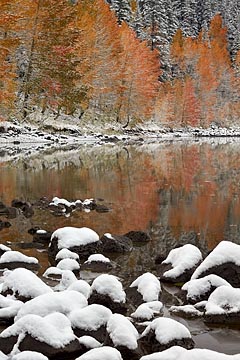
1/15 sec, f13, ISO 100

polarizer, 1/45 sec, f11, ISO 100
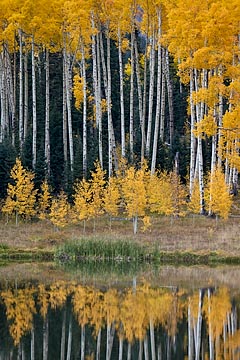
polarizer, 0.3 sec, f11, ISO 100
I moved down to the Uncompahgre National Forest in southwestern Colorado for nine days at the beginning of October to photograph fall color in area that I particularly like. Conditions were good one calm morning to photograph the yellow aspen reflected in a small pond (above right). The clouds were cooperative another morning to photograph a vast forest of yellow aspen (below left). And finally, the clouds were also cooperative one morning above Mt. Sneffels (below right), my absolute favorite landscape subject to photograph in the fall.
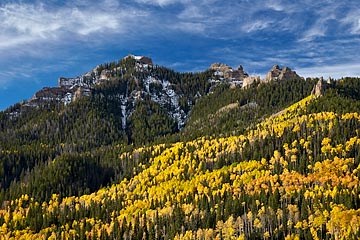
polarizer, 1/45 sec, f8, ISO 100
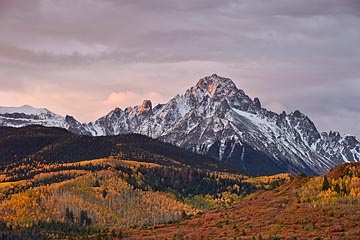
2-stop soft grad ND, 1/4 sec, f9.5, ISO 100
Travel: Grand Staircase-Escalante National Monument, Utah
We moved down to the Grand Staircase-Escalante National Monument in Utah for five days in the middle of October to follow the fall color south. We were a bit early and couldn't stick around for the fall color to fully develop, so I turned my attention to other subjects. The clouds weren't very cooperative the whole time we were there, so I focused on intimate scenes like the tan slickrock in the image below-left and the vibrant red sandstone in the image below right.
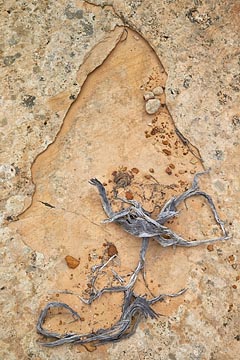
1/15 sec, f11, ISO 100
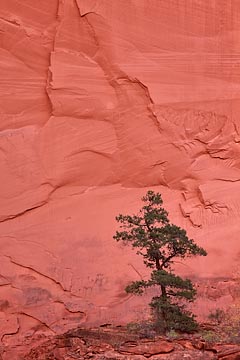
polarizer, 1/4 sec, f11, ISO 100
Travel: Zion National Park, Utah
We camped near Zion National Park for about three weeks from the end of October through the middle of November. We explored a new area of Zion National Park shortly after we arrived, and I spent a lot of time there during our stay. One morning I found a fantastic twisted root system on an overturned dead tree. I kept refining the composition to zero in on what had attracted me, and I ended up with the image below left. I was there another morning after it had snowed lightly overnight, and found this set of branches just screaming for me to take its picture (below center). I had kept going back to that area because I was waiting for the clouds to cooperate above some nice sandstone cones, and they finally did (below right).

2 sec, f16, ISO 100
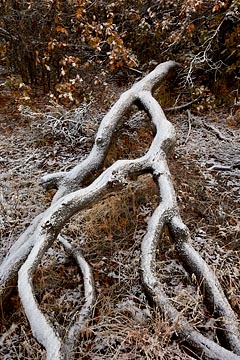
1/6 sec, f13, ISO 100
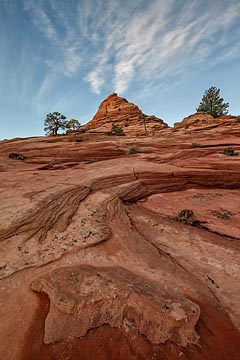
1/30, 1/15, & 1/8 sec; f11; ISO 100
The highlight of our time near Zion was hiking The Narrows up through the Virgin River. I hadn't been up there since I tore the lateral meniscus in my knee and had been itching to get back as soon as my knee was up to it. We timed it just about right for the fall color, and my favorite image is of some cascades looking across the across the river to yellow trees on the far bank (below left). Shortly after I made this image, and while still heading upstream, I tweaked something in my left knee which made it hard to bend and step over the many boulders so I almost fell in a few times before finally turning around and heading back to the car. By the time I got back, my knee was really stiff and I was limping like crazy. Fortunately, a couple days of serious rest was all it took for the knee to mend. A few more days of light use and it was back to where it was before the hike up The Narrows — whew!

2-stop soft grad ND, 3-stop ND,
8 sec, f11, ISO 100
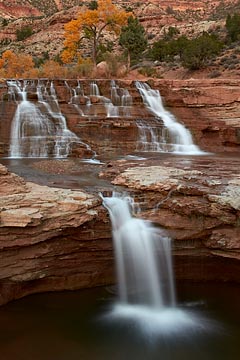
10 sec, f9.5, ISO 100
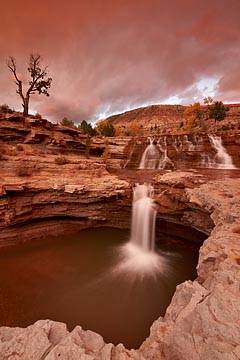
2-stop soft grad ND, 1-stop soft grad ND,
4 sec, f13, ISO 50
We also visited a secret waterfall that Jan discovered in southwestern Utah. On my first visit, the clouds didn't cooperate so I avoided the sky in my compositions (below center). On our next visit, the clouds really lit up at sunset and I was able to take advantage of the wonderful sky (below right). While set up to make this image, the Lee ProGlass ND0.9 three-stop neutral density filter slipped out of the Foundation Kit and split in two on the ground.
Travel: Vermilion Cliffs National Monument, Arizona
We moved over to the Vermilion Cliffs Monument in northern Arizona for ten nights at the end of November. We participated in the walk-up lottery to get a permit to visit The Wave, the iconic destination in North Coyote Buttes, but didn't win so we spent our time in South Coyote Buttes and White Pocket.
After visiting South Coyote Buttes a few times, I finally found a good location for sunset and the clouds cooperated one evening (below left). I already knew of a good location for sunrise and went there when the clouds cooperated (below center).

National Monument, Arizona, USA
1, 2, & 4 sec; f11; ISO 100
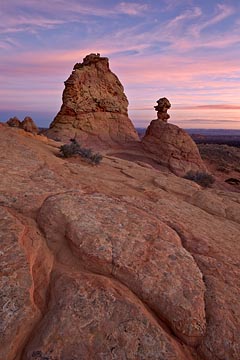
National Monument, Arizona, USA
1/4 sec, f9.5, ISO 100
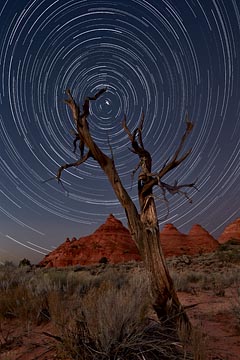
National Monument, Arizona, USA
1.5 sec & 14x 12 min; f13; ISO 100
I've always been intrigued by star trail images, but had never tried it before until this visit. Conditions were perfect one night with a sliver of moon setting an hour and a half after sunset and a forecast for clear skies overnight. I set up at an area that would have an interesting composition looking north, and I'm quite happy with the result (above right). :) When I set up shortly after sunset, I first made a series of exposures that would be appropriate for the fixed part of the image. Then I set up the Canon Timer Remote Controller TC-80N3 to wait for 1.5 hours, then take a series of 12 minutes exposures with 10 seconds in between. It got down to about 20°F (-6°C) over night, and the camera battery only lasted for 14 exposures or 168 minutes. I only used one of the exposures for the fixed part of the image, the darkest, and processed it three times to get a natural-looking night scene: one for the foreground and tree as exposed, one for the sandstone cones adjusted for one stop less exposure, and one for the sky adjusted for two stops less exposure. I processed the star images with high contrast and in B&W to get the most star images with no odd colors. Then I combined the three fixed images to get a natural-looking scene, and put the star images on top in "lighten" mode so that the star trails from each of the images would stick out over the dark sky. Voila — an interesting image.
I also made a lot of intimate images during this visit. I discovered this triangular formation (below left) on the side of a butte, and it was glowing in the reflected light one morning. For the image below center, I had photographed that particular area on a previous visit looking the other direction to emphasize the hook in the upper left. This time I started working the hook from a different perspective and discovered the wonderful zig zag and overall "X" shape. I explored some new areas of South Coyote Buttes on this visit, and discovered a wave-like formation similar to "The Wave." The image below-right begins along the side of the wave and extends around the corner as the many sandstone layers converge.
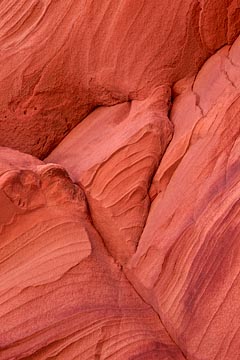
National Monument, Arizona, USA
1/6 sec, f9.5, ISO 100
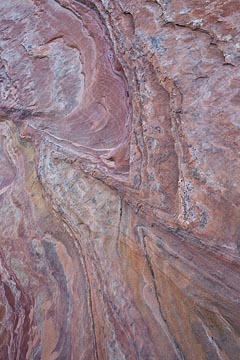
National Monument, Arizona, USA
1/8 sec, f11, ISO 100
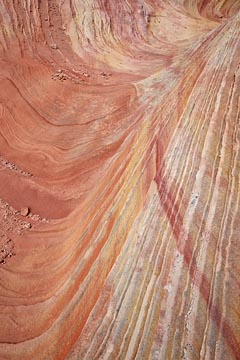
National Monument, Arizona, USA
1/15 sec, f13, ISO 100
Conditions when we visited White Pocket weren't particularly good for grand landscape images, but one evening they turned out great. However, when I first arrived late in the afternoon, I wasn't really excited about the clouds because they were in an odd location and moving away quickly. They were over an area of brain rocks that I haven't photographed much, so it was a real challenge to find an interesting composition. I wasn't finding any interesting compositions and the clouds were breaking up, so I abandoned the attempt and started to make my way to another area. I turned around one last time and saw a possible composition. I set up with my 17 Tilt/Shift and photographed until the remaining clouds were too small then I switched to the 24 Tilt/Shift and finally switched to the 45 Tilt/Shift. The clouds developed some color at sunset, but I stayed in place and the clouds developed some vibrant color about 20 minutes after sunset as shown below left and I was quite happy! I had walked over or near the spot shown below right many times, and one morning I saw the possibility of an image. After working the area for a while, I found a composition that showed off the converging layers.
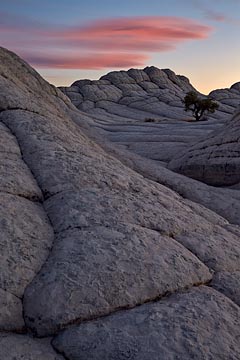
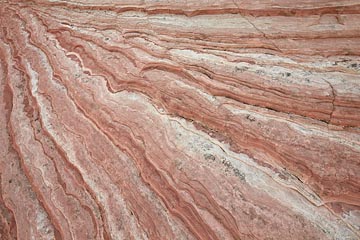
Take care and happy shooting.
— James
James Hager Photography :: www.jameshagerphoto.com




